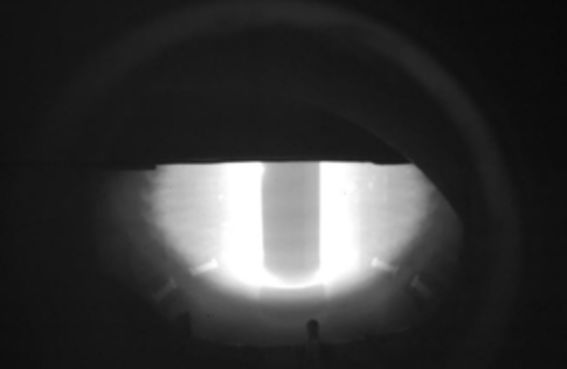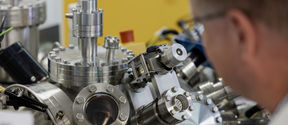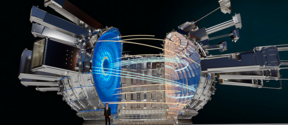MAST Upgrade starts up its first plasma

A flash of purple plasma followed by applause echoing over a video connection: on 29 October, the UK's new fusion device MAST Upgrade officially commenced operation. Patrik Ollus, from Aalto University, is one of the researchers who took part.
Fusion devices have to recreate the process at the heart of the sun. To release energy from hydrogen atoms sticking together in a super-hot, charged gas, or plasma, researchers need to reach temperatures of 150 million degrees Celsius.
The result of a seven-year upgrade programme of UKAEA's Mega Ampere Spherical Tokamak, MAST Upgrade is essentially a completely new machine. The 3-meter-wide device – bigger than an Airbus A380 engine – now features stronger magnets, extra instrumentation to follow and control the seething plasma within, increased heating power in the form of stronger neutral beam injectors and the capability to make its plasma discharges longer, up to 5 seconds.
PhD student Patrik Ollus at the Department of Applied Physics is excited to see the spherical tokamak in action. A computational scientist, he studies atomic effects and how they influence heating throughout fusion plasmas. Such processes are especially influential in MAST Upgrade, which offers an ideal environment to test his predictions.
"I want to make a bridge between theoretical physicists who talk about fine details inside the plasma and engineers who talk about megawatts per square metre on the first wall tiles", explains the PhD student: "I am excited to finally validate our new numerical tool against real measurements from MAST Upgrade. The next step in my research is to make predictions and help in the design of even larger fusion devices."
VTT is in charge of coordinating Finnish fusion research and is involved in the planning and execution of the EUROfusion scientific programme on MAST Upgrade, via Antti Hakola’s role as one of the Deputy Task Force Leaders of the EUROfusion Work Package MST1 (Medium-Size Tokamak Campaigns); all the EUROfusion activities on MAST Upgrade are channelled through MST1.
EUROfusion Programme Manager Tony Donné: "Warm-hearted congratulations to the MAST Upgrade team on behalf of the EUROfusion community. We are looking forward to the scientific results from this machine with its super-long divertor leg, which will give important guidance to ITER and DEMO."
Fusion researchers throughout Europe followed MAST Upgrade's first plasma discharge via remote video connection. The spherical tokamak’s thin centre column is different than the workhorse donut-shape of mainstream devices like JET and ITER, but the European fusion community considers it a worthwhile alternative to explore on its Roadmap to Fusion Energy. UKAEA thinks the compact design may hold the key to small and affordable fusion power plants in the future.
Super X: sitting on the surface of the Sun
MAST Upgrade's crown jewel has to be its complex new divertor or exhaust, designed to efficiently cool outflowing plasma and protect the exhaust wall. Typically, the inner walls of a tokamak are protected from the super-hot plasma contained inside by magnetic fields. The exception is the divertor, which has to survive temperatures and particle impacts only seen on the surface of the Sun. MAST Upgrade was designed to try out new ways of cooling the hot plasma before it touches and erodes the divertor during a normal plasma exhaust process.
To cool the plasma, new magnetic coils near MAST Upgrade's divertor will shape and stretch the exhaust stream into exotic shapes like the stretched Super X or multipronged Snowflake. These give the plasma more time and space to radiate away energy before it finally reaches the divertor wall. By reducing the wear and tear on the divertor, this technique is expected to result in longer lifetimes for future fusion power plants.
Small, flexible machines
"The design of a spherical tokamak lets you get the same level of plasma confinement with a much smaller magnetic field", explains UKAEA media manager Nick Holloway. "If we get this right, we'll have another possible design for a fusion power plant." At the same time, MAST Upgrade is similar enough to mainstream tokamaks that results can be easily transferred between them.
"These tokamaks all have their own specialties and unique insights they can deliver," says Sara Moradi. A plasma physicist with an MBA, she coordinates EUROfusion's research programme for Medium Sized Tokamaks like MAST Upgrade, ASDEX Upgrade (IPP, Germany), TCV (SPC, Switzerland) and WEST (CEA, France). The smaller devices may not reach the high temperatures of the larger JET or ITER tokamaks, but nevertheless they play an important role as testing platforms. Moradi: "Because they're smaller, these setups are inherently more flexible, cheaper and quicker to modify. You can upgrade them in ways that are just not as feasible for a bigger machine."
Getting ready for experiments
Now the first plasma has been achieved and applauded, the UKAEA's physicists and engineers are already working to get MAST Upgrade ready for its first experimental campaign.
COVID-19 lockdowns mean that, at least for now, most of the research will have to be done remotely. Over the past half year, UKAEA has gathered a lot of experience with remote operation of the European flagship tokamak JET at their Culham site. Even so, researchers look forward to visiting in person someday. Even coordinator Sara Moradi has been bitten by the bug: "I hope they'll allow me to come visit the operation of MAST Upgrade at some point. Sitting in the pilot seat at JET, crunching enormous amounts of data and solving unexpected surprises in the 20 minutes between plasma discharges – I miss it!"
If all goes according to plan, MAST Upgrade will run for 10 experimental days in December, with more to come in 2021. A further enhancement campaign in 2023 will be supported by EUROfusion with a programme worth €1.43 million. The planned enhancements include extra neutral beam heating, control upgrades to tame the seething plasma, and a cryoplant to cool away the resulting increased heat load on the divertor.
Contact information
Related stories

Aalto Scientists Experiment with Helium Plasma to Help Pave Way for Fusion Energy
As part of FinnFusion, itself belonging to the EUROfusion consortium, Aalto scientists are experimenting with helium plasma to improve the future operations of Iter, an international fusion energy collaboration under construction in France.
Ten new Academy projects awarded to the School of Science
The projects will investigate questions from nuclear fusion, solar energy, bio inspired materials, and many more
Aalto nuclear fusion expert becomes ITER Scientist Fellow
Dr Antti Snicker becomes the first Finnish Scientist Fellow at ITER, modelling transport of fast particles in tokamak plasmasAcademy of Finland awards seven new projects to the Department of Applied Physics
Grants exceed 3.3 million euros for research in a diversity of physics topics.- Published:
- Updated:
Read more news

DeployAI Partners Gather for Heart Beat Meeting in Helsinki
The European DeployAI project's partners gathered for the Heart Beat meeting hosted by Aalto University Executive Education in Helsinki.
Get to know us: Associate Professor Maria Sammalkorpi
Sammalkorpi received her doctorate from Helsinki University of Technology 2004. After her defence, she has worked as a researcher at the Universities of Princeton, Yale and Aalto.
Aalto computer scientists in ICML 2024
Computer scientists in ICML 2024